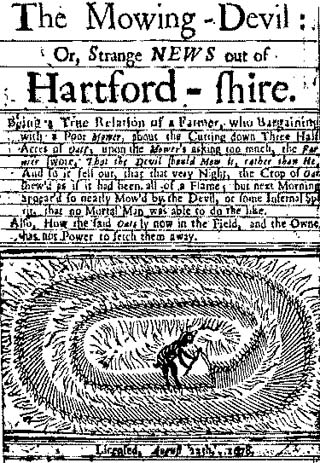 Submitted by Gemini on
Submitted by Gemini on

A 1678 pamphlet entitled The Mowing-Devil is sometimes referred to as the earliest evidence of a crop circle. The pamphlet tells the story of a farmer who made a deal with the devil to mow his field. While the woodcut illustration appears to show a demonic creature cutting the field in a circular pattern, the story indicates that the whole field was mysteriously cut, not just a small section, as in the case of modern crop circles.
Another early case comes from the 19th century. Nature magazine published an article on July 29, 1880, which reported on some circles that amateur scientist John Rand Capron said he'd found in a field near Guildford in Surrey. According to Capron:
The storms about this part of Surrey have been lately local and violent, and the effects produced in some instances curious. Visiting a neighbour's farm on Wednesday evening (21st), we found a field of standing wheat considerably knocked about, not as an entirety, but in patches forming, as viewed from a distance, circular spots.
Examined more closely, these all presented much the same character, viz., a few standing stalks as a center, some prostrate stalks with their heads arranged pretty evenly in a direction forming a circle round the center, and outside these a circular wall of stalks which had not suffered.
Capron thought that the circles he observed were somehow weather related and "suggestive to me of some cyclonic wind action."
Despite the intense interest among the paranormal enthusiasts for supernatural explanations that depend on alternate science or UFOs, the most likely cause for almost all of the crop circles is that they are hoaxes. Even the most ardent fans of either the weather or UFO theories admit that a significant fraction of the circles are manmade. One cereologist, Jenny Randles, a believer in the weather theory wrote: "I would put the hoaxes to comprise something over 50 percent of the total." Another circle researcher, Colin Andrews, working on a grant from Laurance Rockefeller, came to the conclusion that 80% of circles made in the years 1999 and 2000 were manmade and either prompted by business and/or media interests.
The first hoaxsters responsible for crop circles may have been two local gentlemen named Doug Bower and Dave Chorley. According to the two, they conceived the prank over drinks in a pub near Winchester, Hampshire, England in 1978. They found they could build circles quickly using simple tools. At first, there was little reaction to their work, but in 1981 they chose a site for a circle called Cheesefoot head, a hill which was very visible from the nearby motorway. The incident made the papers and all of a sudden crop circles were big news. Because some people argued that the circles were the result of a simple weather phenomenon, the two started making their circles more complex involving intricate geometric forms. The two continued their work until 1991 when they approached a British newspaper acknowledging their actions and demonstrated the technique to reporters. Though Chorley died in 1996, Bower continued to make circles until 2004. Since then, other groups have apparently taken up the practice.
Why don't these backers of the weather or UFO explanations believe that all the circles are hoaxes? Most would argue that a close examination of a circle will reveal differences between a hoaxed circle and a "genuine" circle. There is no clear criteria about what makes a circle genuine, however. In fact, the BBC once asked a circle "expert" to examine a formation they had found. The expert declared it real, only to have to reverse his judgment when the BBC film crew told him they'd had the circle especially built for the occasion.
- 1676 reads